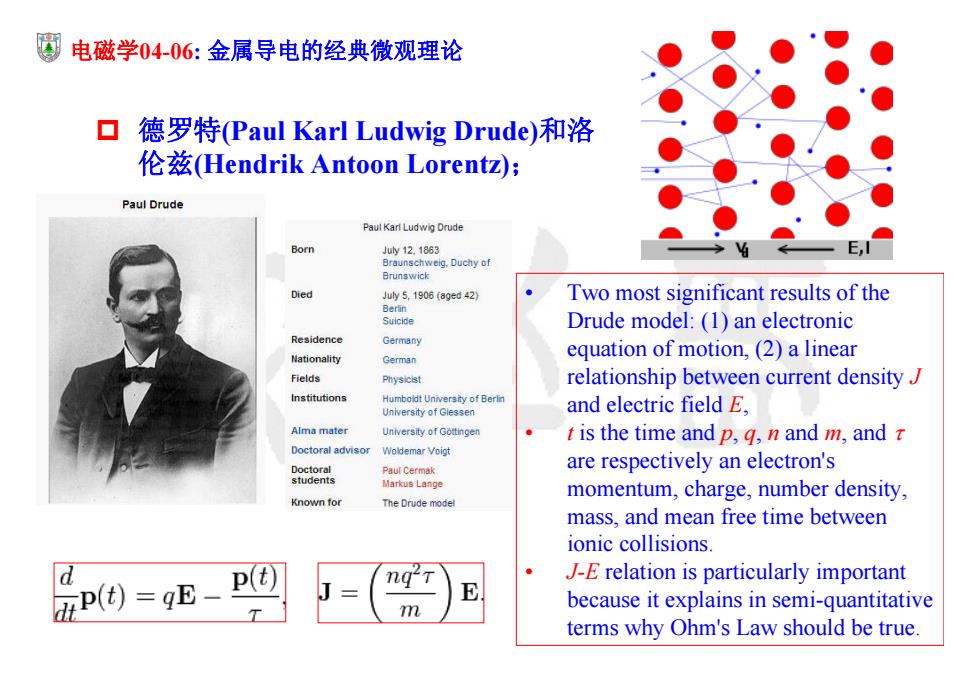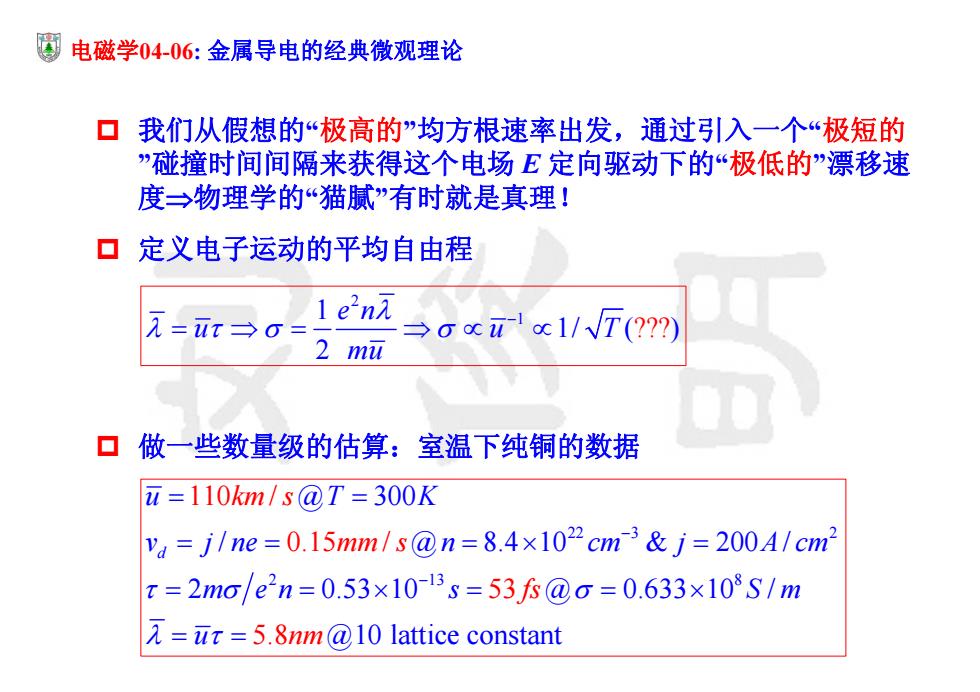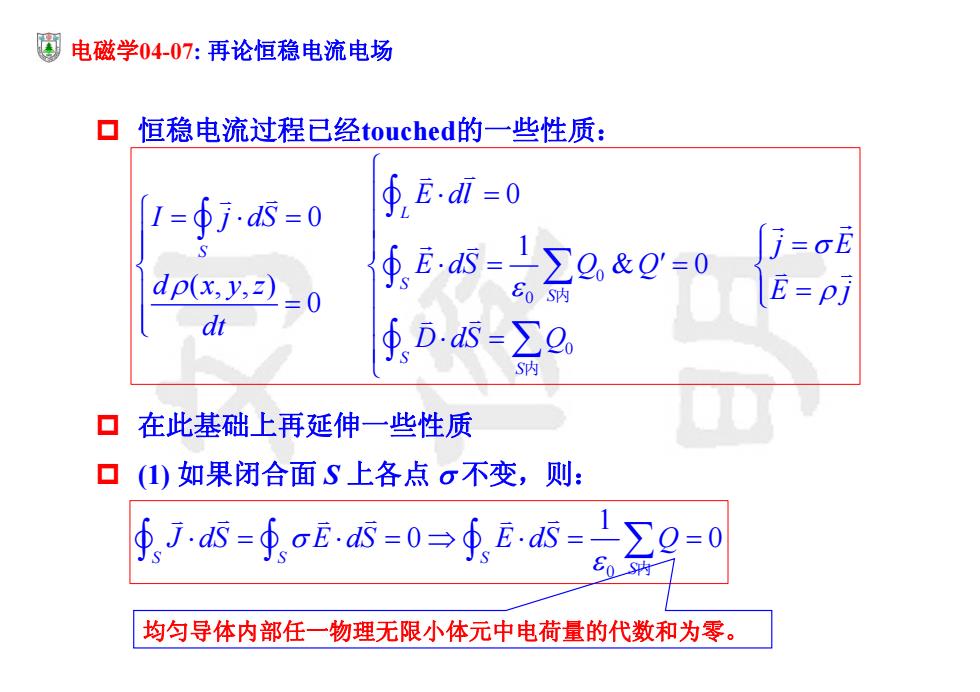
电磁学0406:金属导电的经典微观理论 口德罗特Paul Karl Ludwig Drude)和洛 伦兹(Hendrik Antoon Lorentz忆); Paul Drude Paul Karl Ludwig Drude Born Juy121853 Braunschweig.Duchy of Brunswick Died July 519(4) Two most significant results of the Berin Suicide Drude model:(1)an electronic Residence Germany Nationality German equation of motion,(2)a linear Fields Physicist relationship between current density J Institutions Humboldt Univeraity of Berin Unlversity of Giessen and electric field E. Alma mater University of Gottingen t is the time and p,g,n and m,and t Doctoral advisor Woldemar Voigt Paut Cerm做 are respectively an electron's Markus Lange momentum,charge,number density, Known for The Drude mode! mass,and mean free time between ionic collisions. i(t)=qE J-E relation is particularly important E m because it explains in semi-quantitative terms why Ohm's Law should be true
电磁学04-06: 金属导电的经典微观理论 德罗特(Paul Karl Ludwig Drude)和洛 伦兹(Hendrik Antoon Lorentz); • Two most significant results of the Drude model: (1) an electronic equation of motion, (2) a linear relationship between current density J and electric field E, • t is the time and p, q, n and m, and are respectively an electron's momentum, charge, number density, mass, and mean free time between ionic collisions. • J-E relation is particularly important because it explains in semi-quantitative terms why Ohm's Law should be true

电磁学0406:金属导电的经典微观理论 口德罗特(Paul Karl Ludwig Drude)和洛伦兹Hendrik Antoon Lorentz): Born 18Juy1853 Amhem,Netherlands Died 4 February 1928 (aged 74) Haarlem,Netheriands Nationality Netherlands Fields Physics Alma mater University of Leiden Doctoral advisor Pieter Rijke Doctoral students Geertruida L.de Haas-Lorentz Adriaan Fokker Leonard Ornstein Known for Theory of EM radiation Lorentz torce Lorentz contraction Notable awards Nobel Prize for Physics(1902) Franklin Medal (1917) Right:Albert Einstein and Hendrik Antoon Lorentz,photographed by Ehrenfest in front of his home in Leiden in 1921. Hendrik Antoon Lorentz(18 July 1853-4 February 1928)was a Dutch physicist who shared the 1902 Nobel Prize in Physics with Pieter Zeeman for the discovery and theoretical explanation of the Zeeman effect.He also derived the transformation equations subsequently used by Albert Einstein to describe space and time
电磁学04-06: 金属导电的经典微观理论 德罗特(Paul Karl Ludwig Drude)和洛伦兹(Hendrik Antoon Lorentz); Right: Albert Einstein and Hendrik Antoon Lorentz, photographed by Ehrenfest in front of his home in Leiden in 1921. Hendrik Antoon Lorentz (18 July 1853 – 4 February 1928) was a Dutch physicist who shared the 1902 Nobel Prize in Physics with Pieter Zeeman for the discovery and theoretical explanation of the Zeeman effect. He also derived the transformation equations subsequently used by Albert Einstein to describe space and time

厦 电磁学0406:金属导电的经典微观理论 口载流子:很多实验证实是自由电子Richard Chace Tolman experiment 口导电的电子气理论: 3 m=3kT→√屁=元=6.74×103√Tm/s=110km/s@T=300K 口欧姆(ohm)定律:从△t时间通过面元△S的电子数目开始推导; f=eE→a=eE/m→drift speed va ,△Q=neya△t△S,∴.I=△Q/△t=neyu△S ∴.j=-I/△S=-ne,=pva(drift velocity) eE y=az=x台y,3 0+v eE m 2 2m enrE→o= ent 2m 2m
电磁学04-06: 金属导电的经典微观理论 载流子:很多实验证实是自由电子 Richard Chace Tolman experiment 导电的电子气理论: 1 3 22 3 6.74 10 / 110 / @ 300 2 2 mu kT u u T m s km s T K 欧姆(ohm)定律:从t时间通过面元S的电子数目开始推导; / , / / ( ) d d d d d f eE a eE m drift speed v Q nev t S I Q t nev S j I S nev v drift velocity 1 1 2 2 0 2 2 2 2 d eE eE v va v m m e n j E m e n m

电磁学0406:金属导电的经典微观理论 ▣我们从假想的“极高的”均方根速率出发,通过引入一个“极短的 ”碰撞时间间隔来获得这个电场E定向驱动下的“极低的”漂移速 度→物理学的“猫腻”有时就是真理! 口定义电子运动的平均自由程 1e2n入 元=ut→0= →ocu1c1/√T(?) 2 mu ▣做一些数量级的估算:室温下纯铜的数据 u=110km/s@T=300K a=j/ne=0.15mm/s@n=8.4×102cm3&j=200A/cm2 x=2mo/e2n=0.53×10-13s=53fs@o=0.633×103S/m =ur=5.8nm@10 lattice constant
电磁学04-06: 金属导电的经典微观理论 我们从假想的“极高的”均方根速率出发,通过引入一个“极短的 ”碰撞时间间隔来获得这个电场 E 定向驱动下的“极低的”漂移速 度物理学的“猫腻”有时就是真理! 定义电子运动的平均自由程 22 3 2 2 13 8 @ 300 / @ 8.4 10 & 200 / 2 0.53 10 @ 0.633 10 / @10 latt 110 / 0.15 ice constant / 53 5.8 d u TK v j ne n cm j A cm m e km s mm s fs nm n s Sm u 做一些数量级的估算:室温下纯铜的数据 2 1 1 1/ ( ) 2 ??? e n u uT mu

圜电磁学0407:再论恒稳电流电场 口恒稳电流过程已经touched的一些性质: 1=∮jd5=0 ∮Eai=0 j=GE dp(x,y,) fEs=∑g,&0=0 80S内 E=pj dt ∮,Ds=∑0 S内 ▣在此基础上再延伸一些性质 口()如果闭合面S上各点σ不变,则: ∮5=∮oi=0→∮Ea=∑e=0 0s时 均匀导体内部任一物理无限小体元中电荷量的代数和为零
电磁学04-07: 再论恒稳电流电场 恒稳电流过程已经touched的一些性质: 在此基础上再延伸一些性质 (1) 如果闭合面 S 上各点 不变,则: 0 0 0 0 0 1 & 0 (, ,) 0 L S S S S S E dl I j dS j E E dS Q Q d xyz E j dt D dS Q 内 内 0 1 0 0 SS S S J dS E dS E dS Q 内 均匀导体内部任一物理无限小体元中电荷量的代数和为零